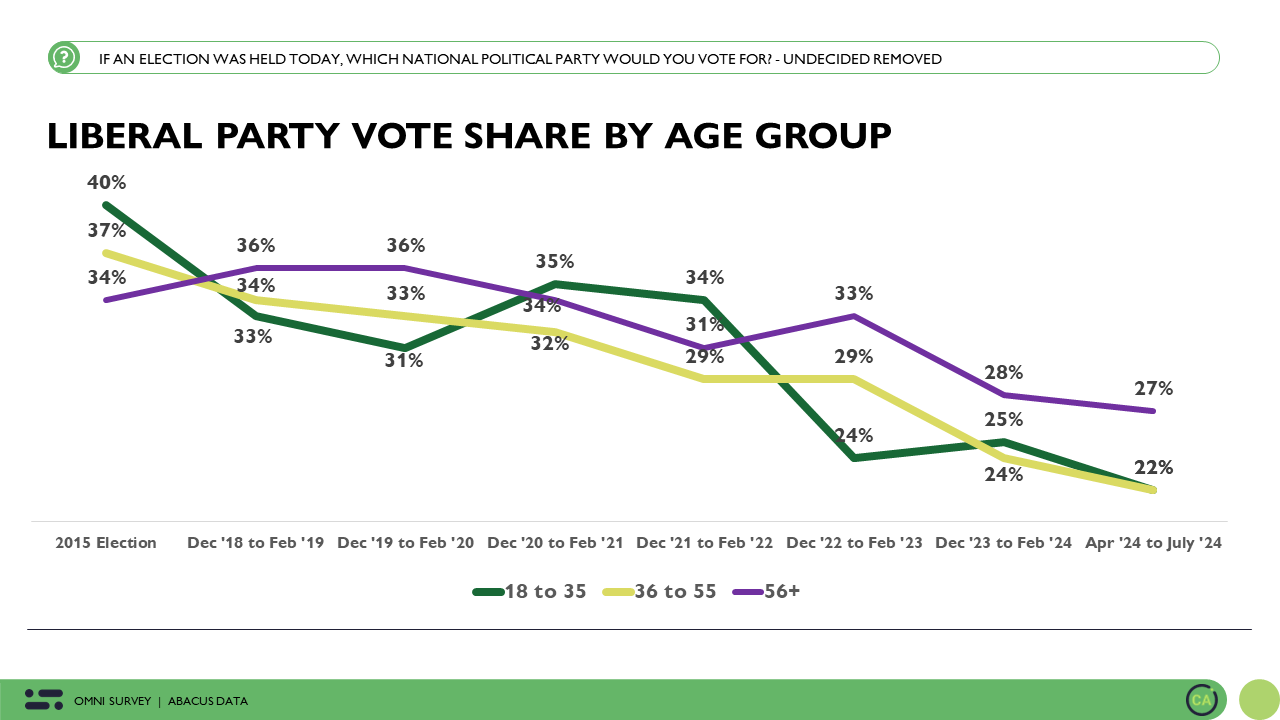The Next Canada: Politics, political engagement, and priorities of Canada’s next electoral powerhouse: young Canadians.
April 19, 2016
Commissioned by the Canadian Alliance of Student Associations
Report written by David Coletto, PhD
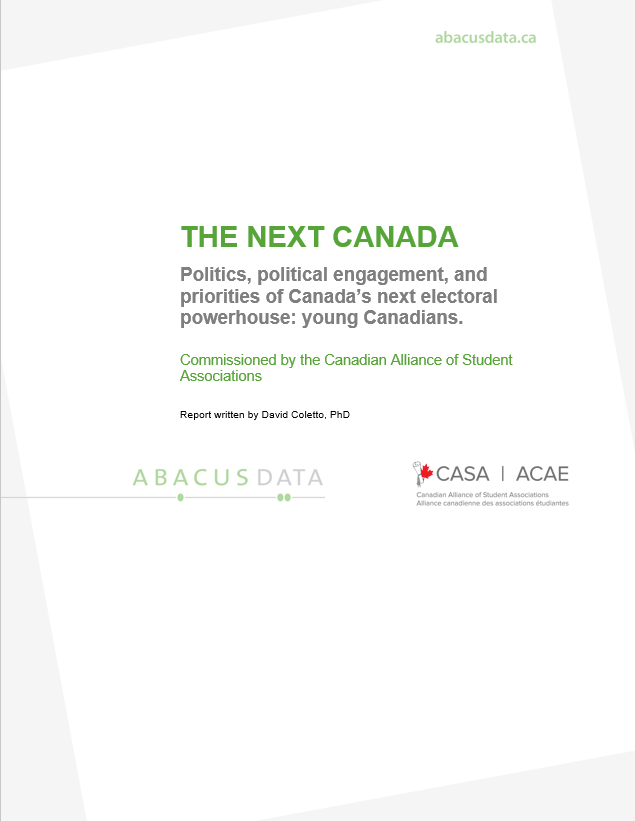
Canada’s New Electoral Powerhouse?
Would you believe me if I told you that young Canadians likely had a major impact on the outcome of the 2015 Canadian general election?
Probably not. That’s because we have continually heard over and over that young people are politically disengaged. Few pay attention to politics. Few vote. And there is plenty of evidence that supports these claims. Elections Canada estimates that during the 2011 federal election, only 39% of Canadians aged 18 to 24 showed up at the polls. In 2008, it was 37%, down from 44% two years earlier.
But the 2015 Canadian election may have been the start of a political awakening of a new electoral powerhouse in Canada.
Early indications suggest that turnout increased upwards of 12 percentage points among the youngest cohort of potential voters, and young voters coalesced around one political party and leader unlike in the past decade. So much so that one could credit young voters with giving the Liberal Party its majority government.
This study, commissioned by the Canadian Alliance of Student Associations (CASA), reports on a range of data sources, including a recent survey of 1,000 Canadians aged 18 to 25 years old. In it, the report explores the recent history of youth engagement in Canadian politics, and reveals findings that indicate that young Canadians voted in greater numbers than in the past, with important consequences.
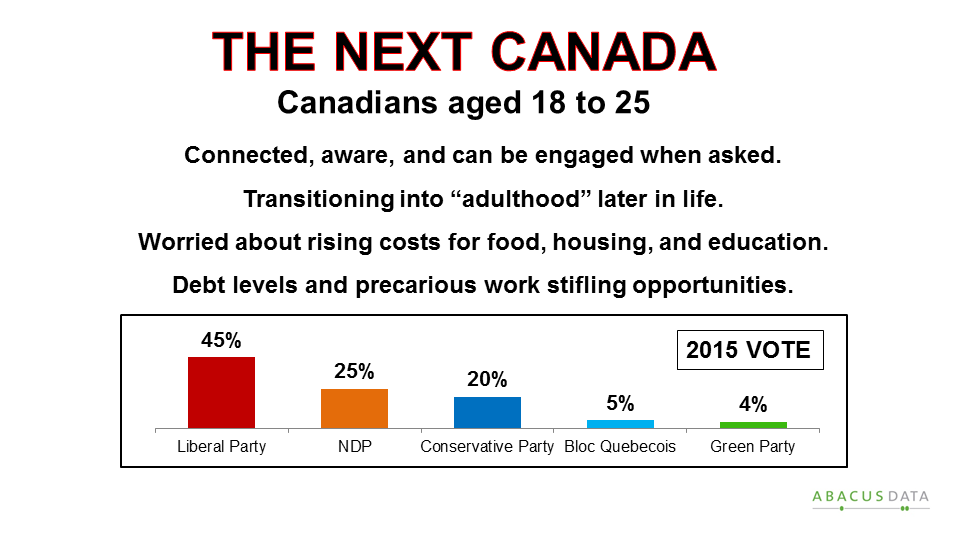
This study also explores how young Canadians feel about the new government less than four months after the election, and what priorities they want the Trudeau government to focus on.
It finds that:
• Voter turnout among 18 to 25 year-olds likely increased by about 12 points in 2015. Evidence indicates that most of the increase in turnout during the 2015 federal election was the result of Canadians under 45 years old coming out in much higher numbers.
• The Liberal Party of Canada won the youth vote in 2015. 45% of young Canadians (aged 18 to 25) voted Liberal compared with 25% for the NDP and 20% for the Conservative Party.
• The NDP lost 43% of its 2011 vote to the Liberals. 43% of those who voted NDP in 2011 voted Liberal in the 2015 election, and 29% of past Conservative voters switched to the red team this time.
• 57% of young Canadians approve of the job performance of the federal government. A plurality of young Canadians think the country is headed in the right direction and that young Canadians think the government should focus its attention on creating better job opportunities for young Canadians, make college and university more affordable and accessible, grow the economy, improve Canada’s healthcare system, and make housing more affordable.
The survey of young Canadians also finds that:
• Support for the Liberals has held since October 2015. In February 2016, 46% of young Canadians would have voted Liberal if an election was held at the time of the survey. The Conservative Party and NDP would have won 19% of the youth vote respectively.
• The Liberal Party has the largest pool of potential voters. The Conservatives are behind the Green Party. Seven in ten young Canadians would consider voting Liberal, 12 points higher than the NDP, and 33 points higher than the Conservative Party.
• Prime Minister Trudeau is viewed positively by 60% of young Canadians, and he’s a political leader that 66% of young people say they can relate to.
But the report does not just focus on politics. It also includes data on the state of mind of young Canadians and the barriers they face finding meaningful employment. While eternally optimistic, young Canadians are also realists and aware of the difficult job market they are facing. The rising costs of food, housing, education, and precarious work options is shaking their faith in what’s possible. They have high expectations that the new government in Ottawa will make their lives better.
The report finds that:
• Large majorities of young Canadians are being negatively impacted by rising food prices, unaffordable housing, and the cost of PSE.
• A majority of current post-secondary students are worried about the amount of student debt they will graduate with, about the number of jobs opportunities waiting for them when they graduate, and their ability to save enough to buy a home within five years of graduation.
• The top ranked barrier to finding a job for young Canadians is not having the experience employers are looking for.
• 75% support an increase in grants to low and middle income students
The 18 to 25 year-olds we surveyed and highlight in this report are part of Canada’s Millennial generation; the largest cohort of Canadians, and soon to be the majority of Canada’s workforce.
In the past, their political voice has been muted by their lack of engagement and participation.
But the 2015 election was different. Hundreds of thousands of new voters cast ballots on October 19, most of whom were young and had never voted before.
And among those aged 18 to 25, almost half of them voted for a political leader they felt understood them and their issues, could inspire them to get involved, and most importantly, a leader they could relate to, who spoke to them on their terms, and where they were.
While they still punch below their weight electorally, young Canadians represent a powerful new political force that will continue to shape the future of Canadian politics for the next three decades, much like their parents’ generation, the Baby Boomers, did for the previous three.
Policy makers, politicians, and other community and business leaders who fail to listen and engage with this new force will be left behind as the NEXT CANADA emerges.
Methodology
This study was commissioned by the Canadian Alliance of Student Associations and is the first of its kind to study the political preferences, priorities, and opinions of Canada’s youngest cohort of voters: those aged 18 to 25.
The survey informing this study was conducted online with 1,000 Canadians aged 18 to 25 from February 8 to 15, 2016. A random sample of panellists was invited to complete the survey from a large representative panel of Canadians, recruited and managed by Research Now, one of the world’s most respected online sample providers.
The Marketing Research and Intelligence Association policy limits statements about margins of sampling error for most online surveys. The margin of error for a comparable probability-based random sample of the same size is +/- 3.2%, 19 times out of 20. The data was weighted according to census data to ensure that the sample matched Canada’s population aged 18 to 25 according to age, gender, educational attainment, and region. Totals may not add up to 100 due to rounding.
Introduction
Young Canadians: A voter group punching under its weight class
Apathetic. Disengaged. Politically illiterate. All these terms have been used to describe young Canadians and their interaction and participation in Canadian political life.
As Brenda O’Neill wrote in 2007,
“Young Canadians display a pattern of civic and political engagement that differentiates them from other Canadians. They are less likely to vote, are less likely to be members of political parties and interest groups, are less interested in politics and know less about politics than other Canadians.”
The result of a lack of participation in formal politics has been that the voice of young Canadians at the policy table has been muted. There’s no doubt, especially considering evidence since 2004, that young Canadians have been punching below their “electoral weight class” for some time.
Elections Canada estimates that turnout among the youngest cohort of electors (18 to 24 years old) has ranged between 37% and 44% in the four federal elections between 2004 and 2011. At no point in the last decade has more than 50% of Canadians aged 18 to 24 come out to vote in a federal election.
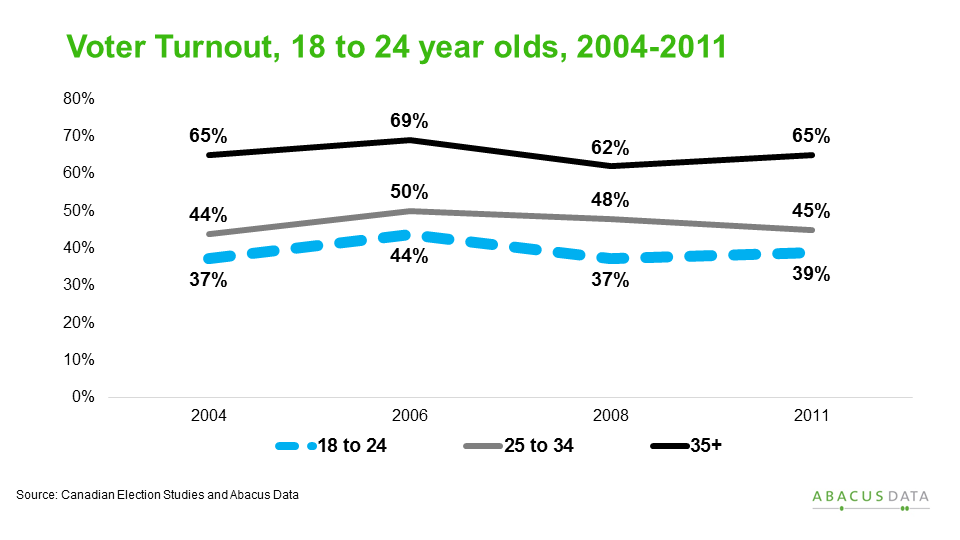
Meanwhile, voter turnout among older Canadians (aged 35+) has been consistently much higher, ranging from 62% to 69%. In the 2011 federal election, Elections Canada estimates that 39% of those aged 18 to 24 turned out to vote. That’s 6 points lower than those aged 25 to 34, and 26-points lower than those aged 35 and older.
Lower turnout among young Canadians has meant their actual “voting power” has not matched their expected “voting power” when one considers the size of the cohort relative to the entire electorate.
For example, in 2011, those aged between 18 to 24 represented approximately 11.7% of the electorate, and yet made up only 7.8% of voters, meaning Canada’s youngest voters only met two thirds of their potential voting power – leaving a third of it at home. In that same 2011 federal election, electors aged 35 and over were more influential than they should have been as that group’s share of voters was three points higher than its share of the electorate.
Voting power refers to how closely a group’s influence among those who voted matches its size of the electorate. A higher voting power means that a group exerts more influence on an election than its population size share would merit.
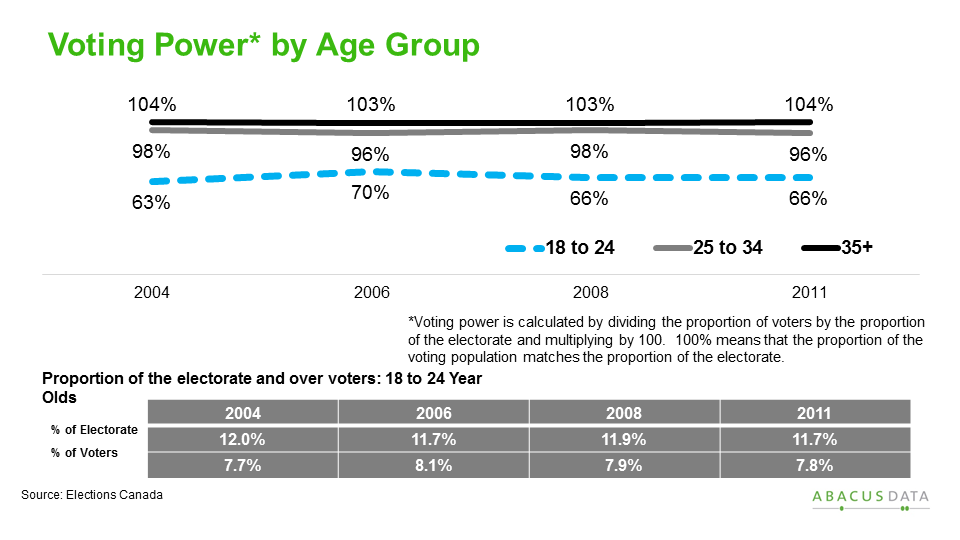
And which age group punched above its “electoral” weight class? Those aged 75 and older, whose voting power was 111%, or 45 points higher, than 18 to 24 year-olds. Canadians aged 75 and older in 2011 represented 8.3% of electors, but accounted for 9.1% of those who voted.
While young Canadians have consistently been less likely to vote than their older counterparts, their collective vote choice has neither been stable nor monolithic. The chart below tracks the stated vote choice of Canadians aged 18 to 30 from 1997 to 211 using Canadian Election Study data (1997 to 2011).
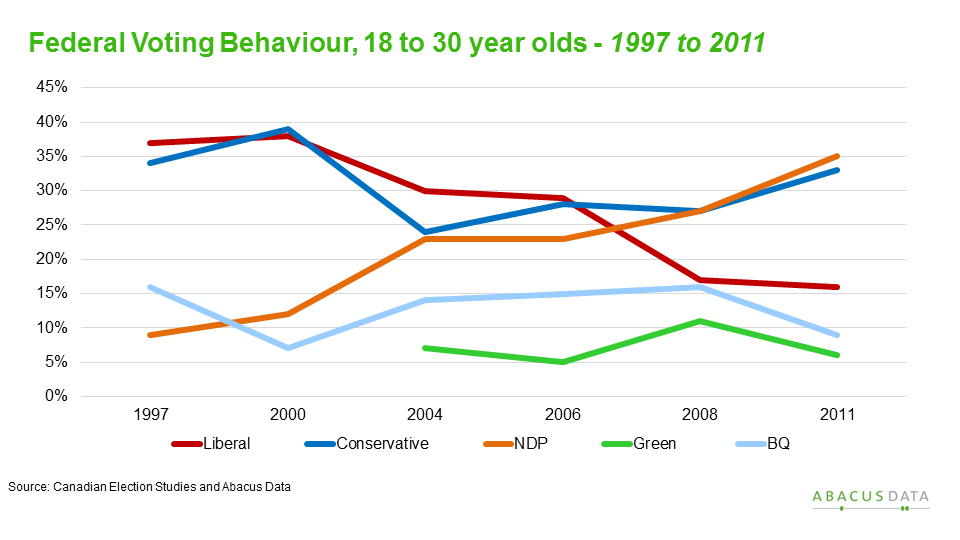
For most of the period from 1997 to 2011, no single party had a significant advantage among young voters. From 1997 to 2006, the Liberals could count on at least 30% of the youth vote. After 2006, Liberal support among young people took a sharp dive, dropping to 17% in 2008 and 16% in 2011.
For the Conservatives, despite the perception that young people do not vote for conservative parties, the united Conservative Party, or the combination of its predecessor parties – could count on at least 25% of the youth vote from 1997 to 2011.
The NDP, on the other hand, has seen its support among young voters improve over this period. In 1997, only 9% of those aged 18 to 30 cast a ballot for the NDP. In 2004, the first election with Jack Layton as its leader, support increased to 23%, and peaked in 2011 at 35%; 5 points higher than its overall popular vote in that election.
Politically apathetic or ignored? Young Canadians and political participation
Young Canadians are much less likely to vote than older Canadians, and they rarely coalesce around a single party. These two factors might explain why some believe policy makers in Ottawa and in provincial capitals and political parties have rarely tried to engage and mobilize this group.
The return on investment of time, money, and political capital is low when it comes to young Canadians. And so a spiral of disengagement continues: politicians pay less attention to young Canadians because they don’t vote, and young Canadians pay less attention to politics because our political leaders ignore or don’t seem to understand them.
But was the 2015 Canadian election different?
The 2015 Canadian Election
Early evidence suggests that youth voter turnout sharply increased in the 2015 Canadian election. A survey conducted by Statistics Canada suggests that voter turnout among 18 to 24 year-olds was 12 points higher in 2015 than in 2011.
The February 2016 Labour Force Survey asked people whether they had voted in the federal election. Comparing the same survey conducted in 2012 and 2016 offers us an opportunity to estimate the change in turn across age groups.
We should note the difference between actual turnout estimates (reported earlier) and reported turnout collected from survey data.
As academic research has found,
“Surveys usually yield rates of voting in elections that are higher than official turnout figures, a phenomenon often attributed to intentional misrepresentation by respondents who did not vote and would be embarrassed to admit that.”
The data from Statistics Canada indicates that turnout increased the most from 2011 to 2015 among those under the age of 25, with double digit increases across all three age groups. Estimated turnout increased 12 points among 18 to 24 year-olds, 11 points among 25 to 34 year-olds, and 10 points among 35 to 44 year-olds. In contrast, turnout estimates among those aged 55 and over increased only marginally by 1 to 3 percentage points.
This evidence suggests that much of the increased voter turnout in 2015 came from eligible voters under the age of 45.
In our survey of 18 to 25 year-olds, 67% of respondents said they voted in the October 2015 election, while 33% reported not voting for various reasons.
It is worth nothing that the reported turnout estimate in our survey matches the estimate in the Statistics Canada survey providing further evidence that our survey is representative of Canadians aged 18 to 25.
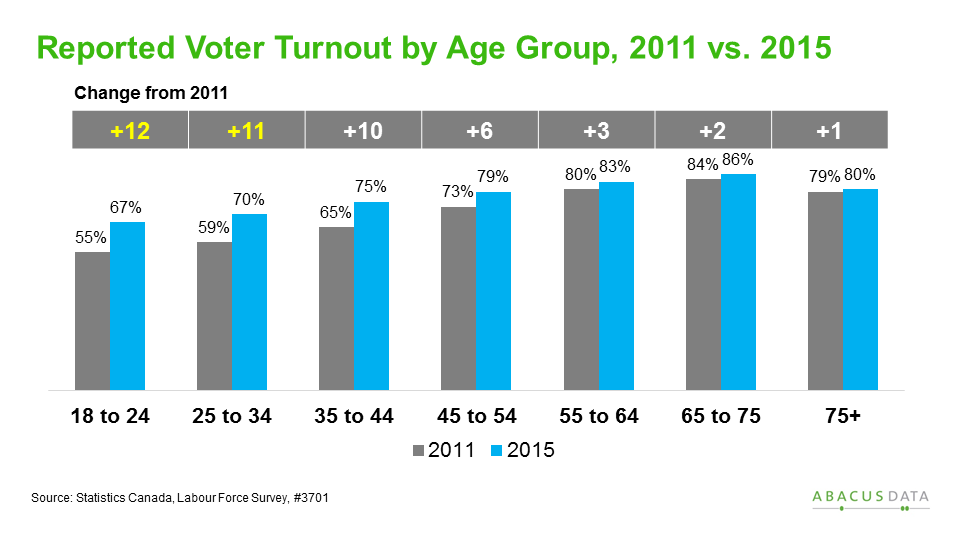
Reported turnout was the same among young men and women (67%), while those aged 18 to 20 were less likely to say they voted than those aged 21 to 24. Not surprisingly, those who said they are politically engaged and follow political news closely were more likely to report voting than those not engaged or who do not follow political news closely.
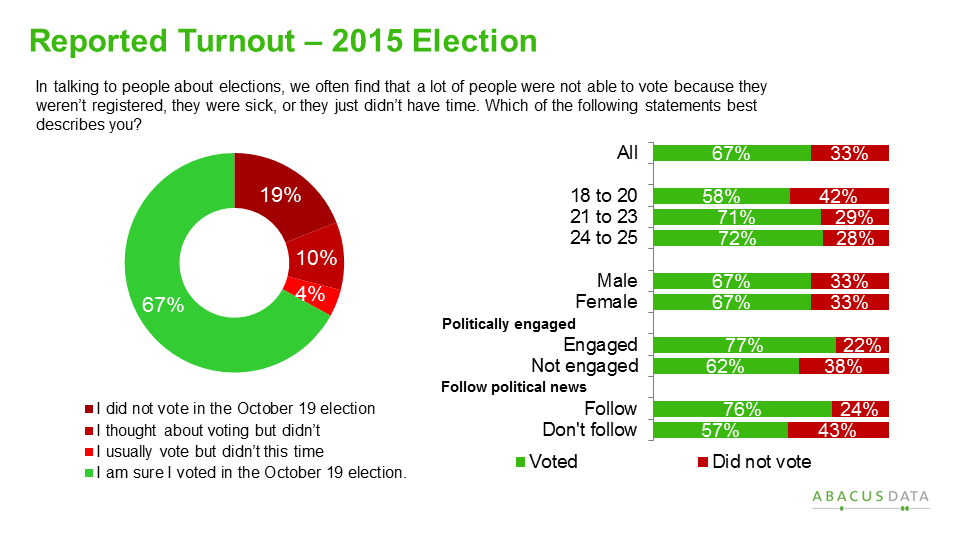
Post-secondary students were also more likely to vote in the October federal election. Over seven in ten (72%) post-secondary students aged 18 to 25 reported voting, compared with 59% of those not enrolled in post-secondary education aged 18 to 25.
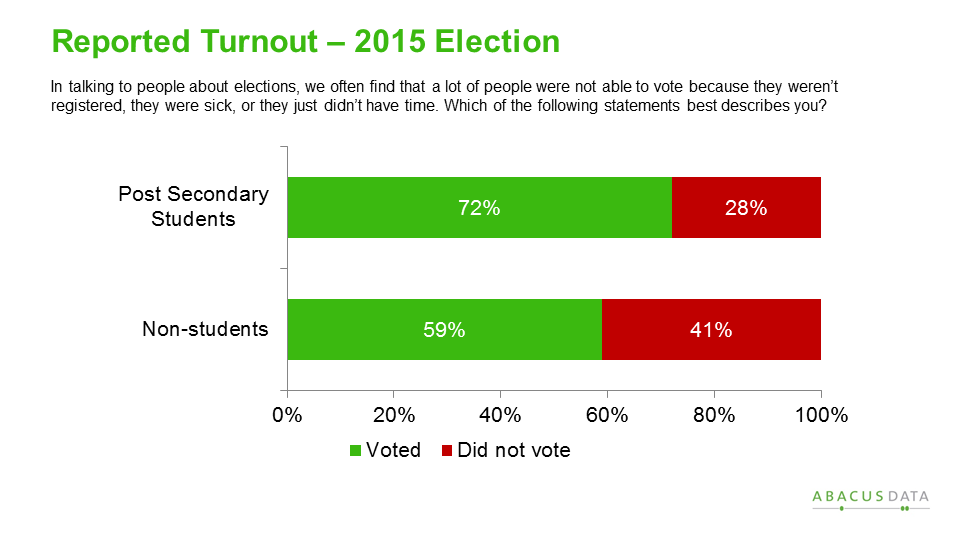
One reason for the higher voter turnout among young Canadians may have been the efforts by organizations to increase youth voter turnout. For example, CASA and Apathy is Boring actively engaged youth participation in the fall election. This work seems to have been effective, with over one in three of youth who voted (37%) reporting being encouraged to vote by an organization working to increase turnout among younger voters.
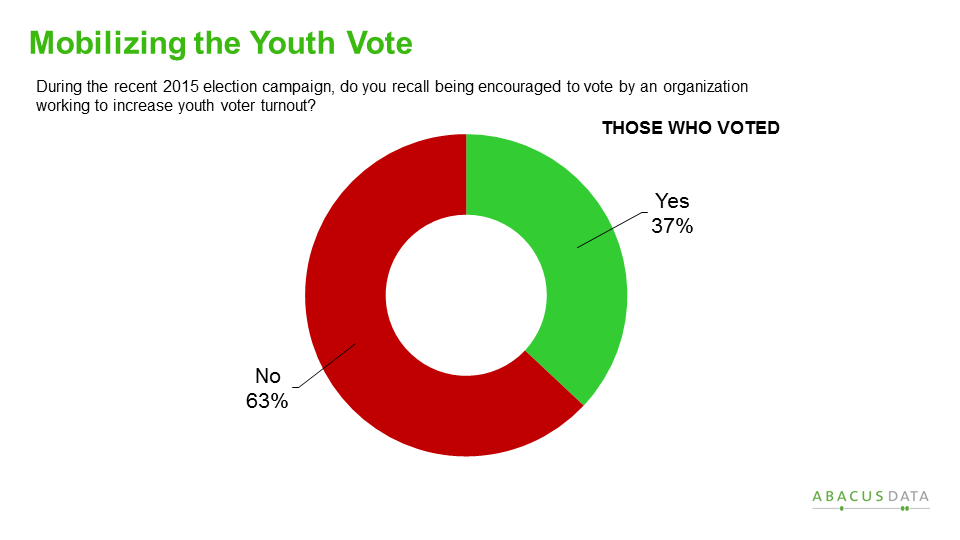
And campaigns to mobilize the youth vote seem to have been more effective at targeting post-secondary education (PSE) students, who were 10-points more likely to recall being encouraged to vote by an organization.
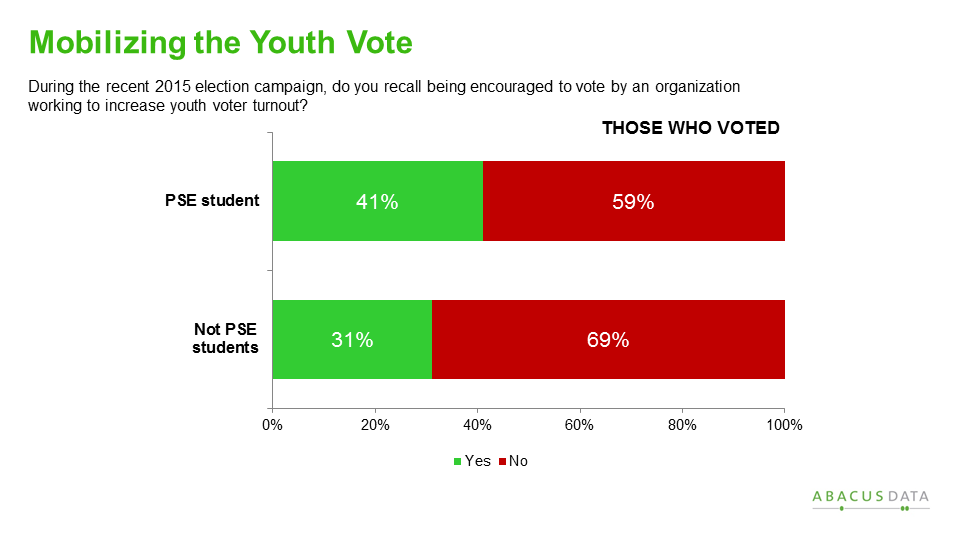
Not only was reported voter turnout higher than in previous elections, a majority of young Canadians also believed that more young people voted in the 2015 election than in the past. Sixty percent of respondents believe that more young people voted than usual, while only 7% felt that fewer young people had voted. The remaining 33% believed that youth turnout was about the same as usual.

Youth Political Engagement
One in three young Canadians in Canada describe themselves as politically engaged, while 52% say they follow news about national politics very closely or somewhat closely.
Reported voter turnout in the last federal election was 15-points higher among those who describe themselves as politically engaged (77% to 62%), and 19-points higher among those who follow political news closely (76% to 57%).
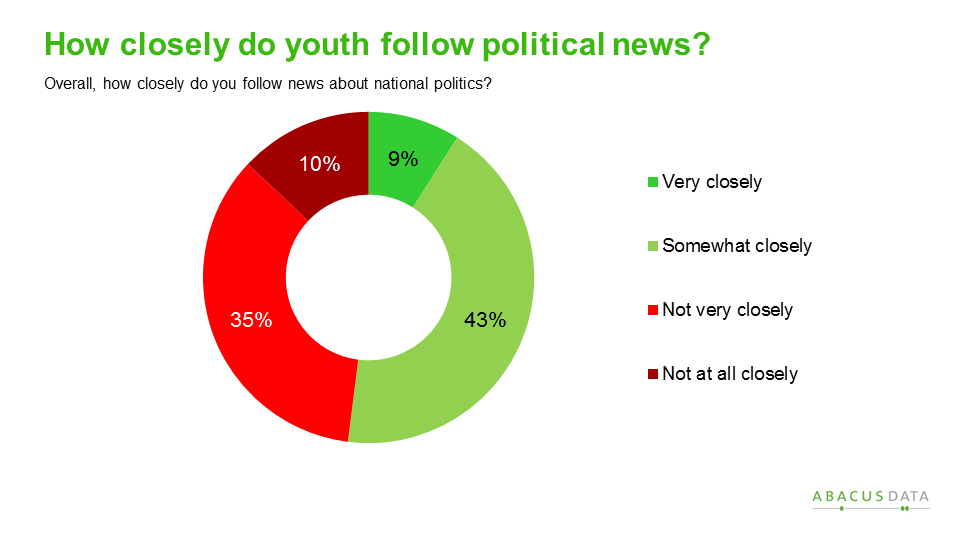
Vote Choice in 2015: The Liberals win young voters by a big margin.
The Liberal Party won a large plurality of the vote among Canadians aged 18 to 25. Of those who voted, 45% voted Liberal, 25% voted NDP, and 20% voted Conservative. 5% voted BQ while 4% voted for the Green Party.
The Liberals won by a large margin among men and women and across age groups. They also won the youth vote in every region of the country, including in Alberta.
In Atlantic Canada, the Liberals won 63% of the youth vote; 42 points more than the NDP. In Quebec, 35% of youth voted Liberal; 11 points more than the NDP and 14 points more than the BQ. The Liberals won Ontario by 21 points, Manitoba and Saskatchewan by 12 points, BC by 11 points, and Alberta by 7 points.
For the Conservative Party, Alberta was the only region or province where at least a third of young voters supported the party. In every other region or province, the Conservatives were either the third or fourth placed party.
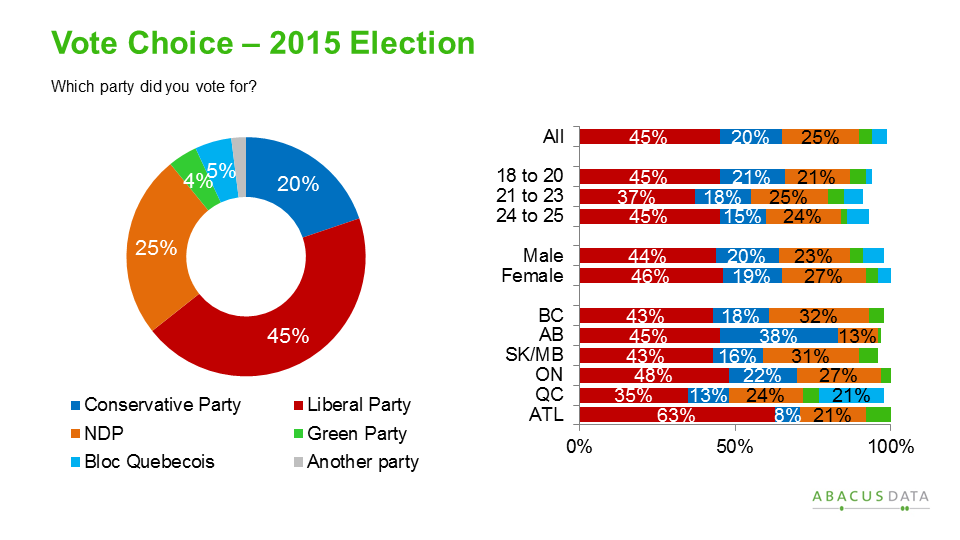
There was little variation between youth currently enrolled in post-secondary school and those who are not. The Liberals won 43% of the vote among those aged 18 to 25 enrolled in post-secondary, and 40% of those who are not enrolled.
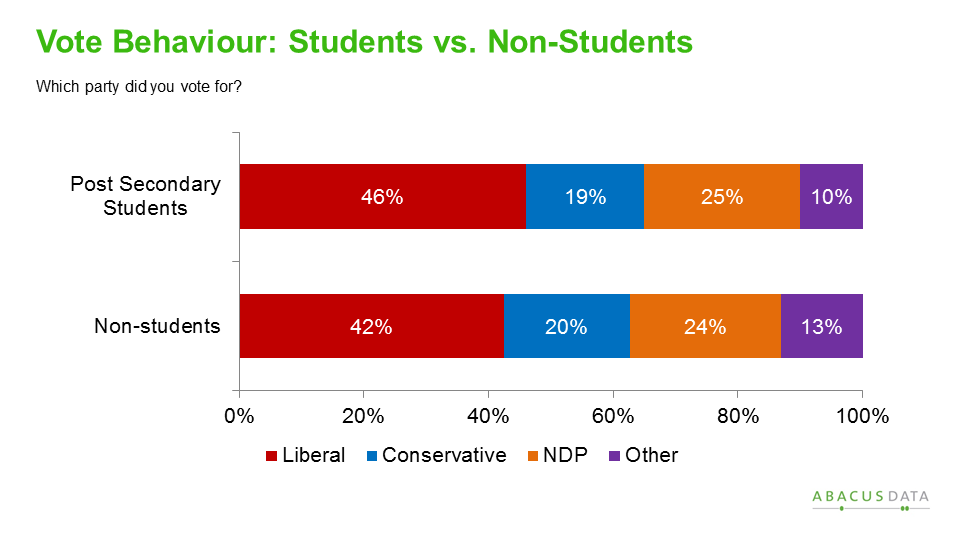
The survey also asked respondents whether they voted in the 2011 federal election, and if so, which party they supported. Overall, 41% of those surveyed said they voted in the 2011 election.
A plurality of youth (36%) voted for the NDP in the 2011 federal election, followed by the Conservative Party with 24%, and Liberals as the last of the major federal parties with 17%.
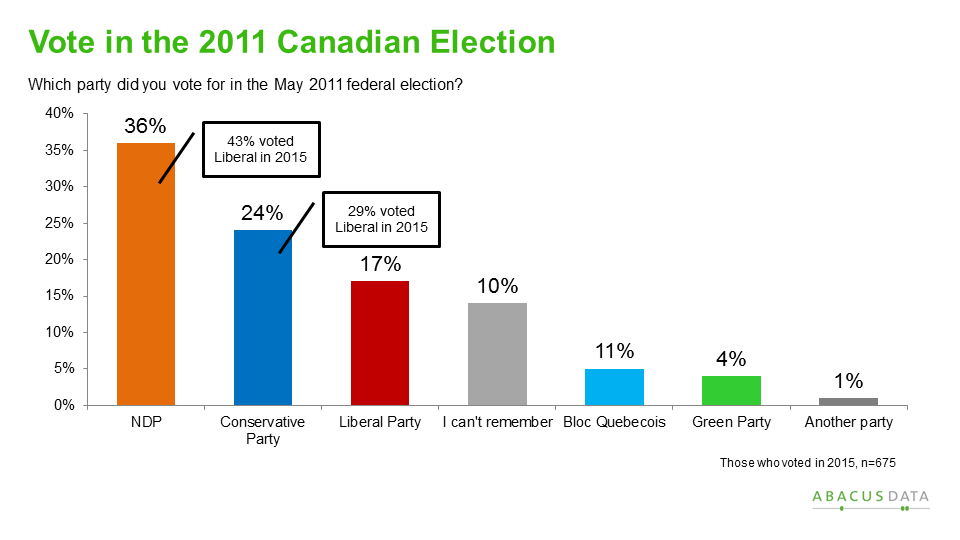
Liberal gains among young voters between 2011 and 2015 came from voters who previously voted NDP and Conservative. Among those who voted NDP in 2011, 43% voted Liberal in 2015, while 29% of 2011 Conservative voters voted Liberal in 2015.
Of note, there was no significant difference in voting behaviour between those who voted in 2011 and those who did not vote. Between both groups, the Liberals won 41% to 42% of the vote.
The 2015 Election was also remarkable for the overall shift in vote choice from one election to the next.
Looking at change in voting behaviour across age groups, the Liberal Party went from third in popular support to first, thanks to double-digit growth in support among all four age groups. However, Liberal support, as a share of an age group vote, grew the most among those under the age of 45, increasing 30-points among 18 to 29 year-olds and 31-points among those aged 30 to 44.
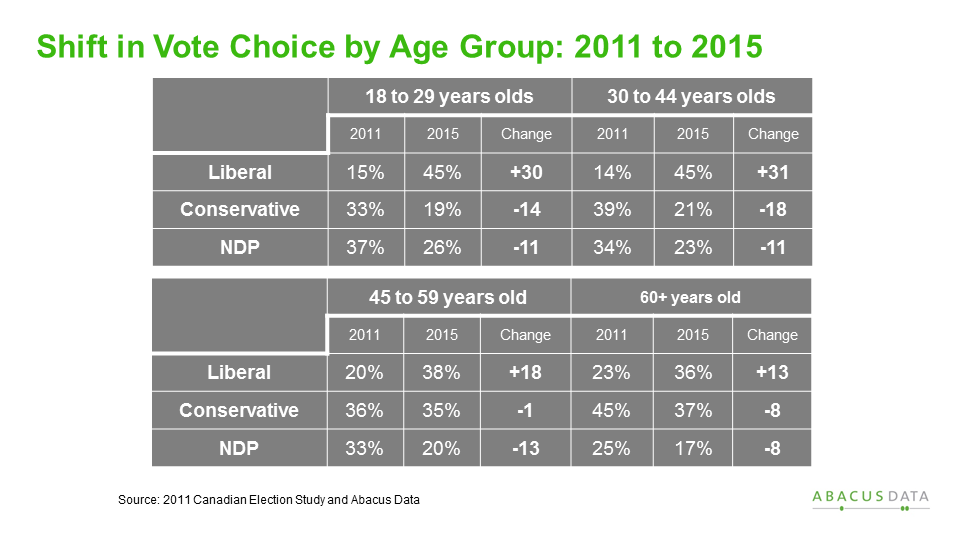
Why did some young people not vote in October 2015?
When asked what the main reason as to why non-voters did not cast a ballot, a lack of comfort and knowledge was more likely to be mentioned than inconvenience, a lack of efficacy, or lack of knowledge about where or how to vote.
Overall, one in three young non-voters said they didn’t know enough about the issue, parties, or candidates, to feel comfortable voting. Another 26% said they didn’t have time or couldn’t make it out to vote, while 11% reported not liking any of the political parties. Only 4% said they didn’t vote because they felt their vote would not count.
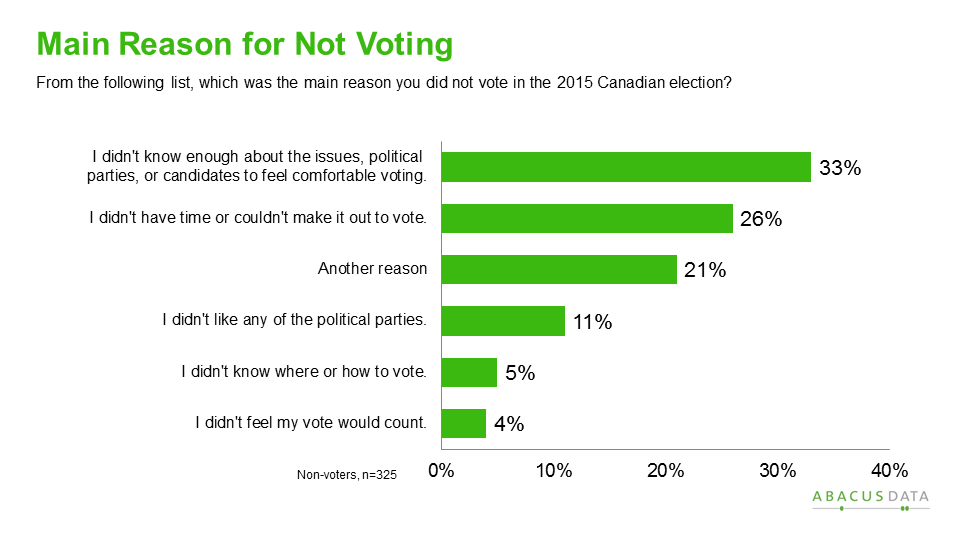
These results indicate that non-voting is not simply due to young Canadians being apathetic or feeling like their vote would not count. To the contrary, the most cited reason was a lack of knowledge or political confidence.
Priorities and Politics in 2016
How do young Canadians feel about the country and its political leaders today?
Youth are also generally optimistic about Canada’s future; a plurality of youth (44%) think that Canada is headed in the right direction, while only 23% believe it is on the wrong track. However, a significant amount (about a third) are unsure about the future.
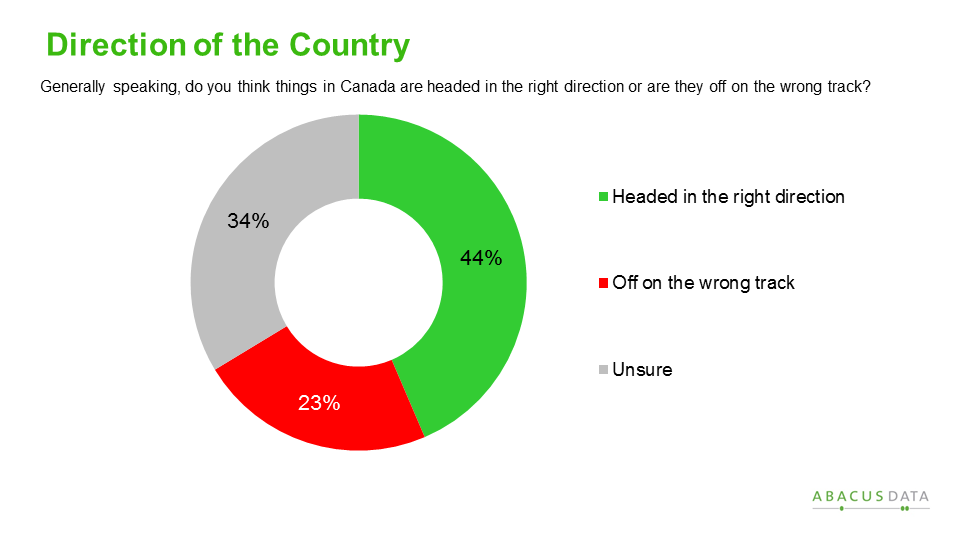
Post-secondary students are more likely to think Canada is headed in the right direction (48%) than those not currently enrolled in school (38%).
Past vote was also a strong predictor of one’s current mood. 68% of Liberal voters think the country is headed in the right direction, while only 10% think it is off on the wrong track. In contrast, only 16% of Conservative voters think the country is headed in the right direction.
When asked about the job performance of the federal government, 57% of young Canadians approve of the job it has done, compared with 18% who disapprove. Another 25% neither approve nor disapprove.
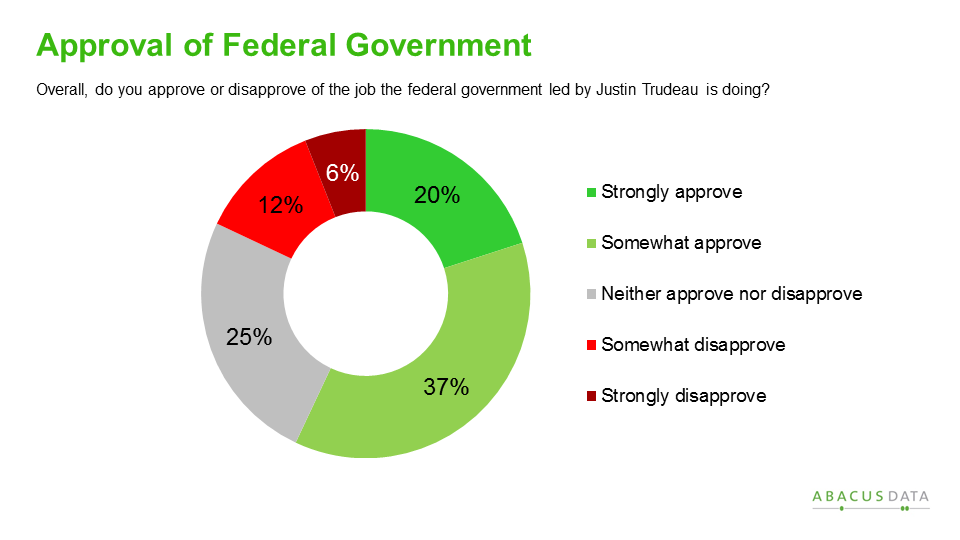
The government’s approval rating among younger voters is higher than among Canadians aged 30 and over. In a survey conducted by Abacus Data in March 2016, 51% of Canadians approved of the job performance of the federal government, while 18% disapproved.
84% of those who voted Liberal in 2015 approve of the job the federal government is doing, as do 63% of those who voted NDP. Only 2% of Liberal voters disapprove – a remarkably high level of satisfaction for the government thus far. Of note, one in four Conservative Party voters approve of the job the government led by Justin Trudeau is doing.
What do young Canadians want the new government to focus on?
Respondents were shown a list of issues that the new federal government and Prime Minister Trudeau could focus on over the next year. They were asked to pick the five they would want him to focus on.
Overall, a majority of young Canadians emphasized the creation of better job opportunities for young people (63%), making college and university more accessible and affordable (60%), growing the economy (55%), improving Canada’s health care system (54%), and making housing more affordable (51%) as their top five issues.
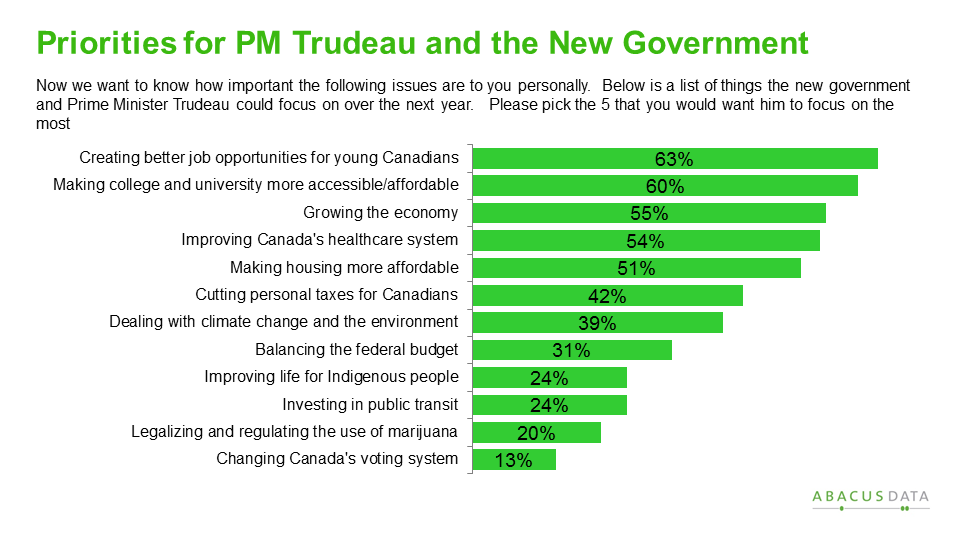
When asked for their top priority, 17% selected creating job opportunities for young Canadians, 15% selected making college and university more accessible and affordable, and 14% selected growing the economy.
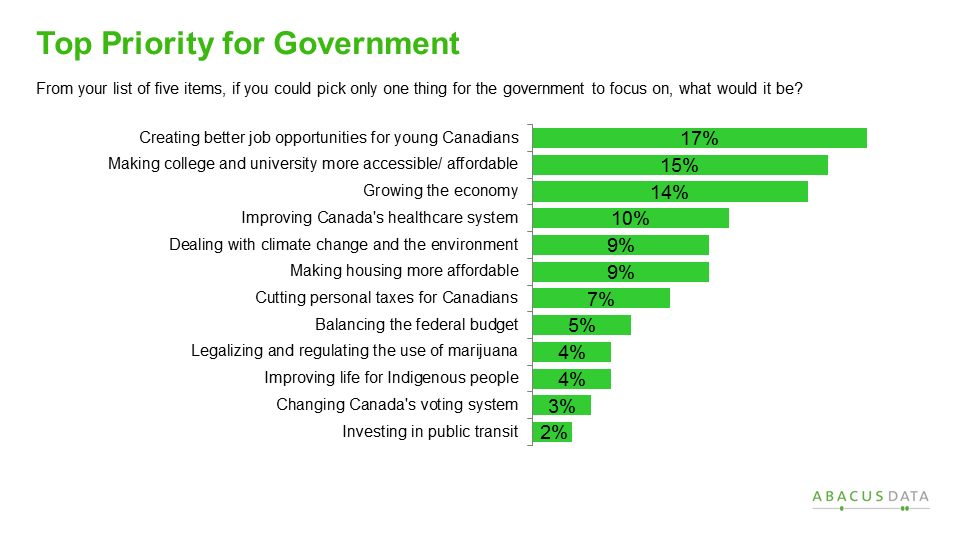
Of note, youth in Alberta were more likely to select “growing the economy” (30%), Quebec youth were more likely to select improving healthcare (19%), while Ontario youth were more likely to select creating better job opportunities for young people (21%).
On their Radar: Which political parties would young Canadians consider voting for?
The Liberal Party not only won the largest share of the youth vote in 2015, it also currently has the largest pool of potential voters. Over seven in ten young Canadians (72%) said they would consider voting Liberal. This is 12 points higher than the NDP (60%), 27 points higher than the Green Party (45%), and 33 points higher than the Conservatives (39%).
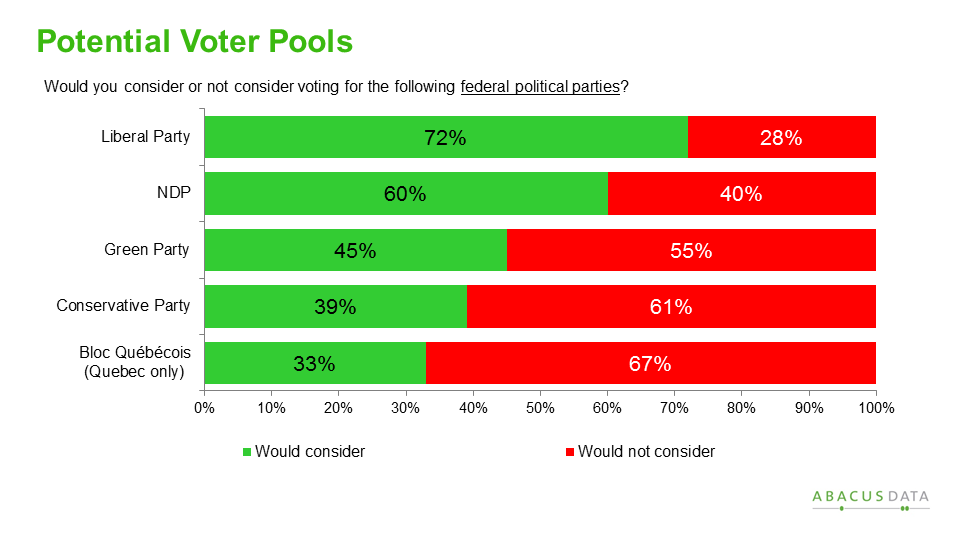
Two points are worth mentioning here. Firstly, while the Liberals enjoy a large lead in vote intention and potential voters, the NDP remains a real threat for the party. Six in ten young Canadians would consider voting NDP (including 57% in Quebec and 63% in Ontario). Remember, the NDP won the youth vote in 2011, and outperformed the Liberals in 2008.
Second, the Conservative Party lost far more support among younger voters than it did among older voters. Less than four in ten 18 to 25 years would even consider voting Conservative, with much of that potential support concentrated west of Quebec. East of the Ottawa River, in Quebec and Atlantic Canada, only 24% of young voters would consider voting Conservative, which is 20 and 40 points lower than the potential voter pools for the Green Party and Liberal Party respectively.
Impressions of the Political Party Leaders
One of the main reasons why the Liberal Party is so popular among young Canadians is because its leader, Justin Trudeau, is so popular among this cohort. 60% of young Canadians have a positive impression of the Prime Minister, while 15% have a negative impression. In contrast, NDP Leader Tom Mulcair is viewed positively by about half as many young Canadians (34%) as Mr. Trudeau. In fact, none of the current party leaders comes anywhere near Mr. Trudeau in terms of popularity.
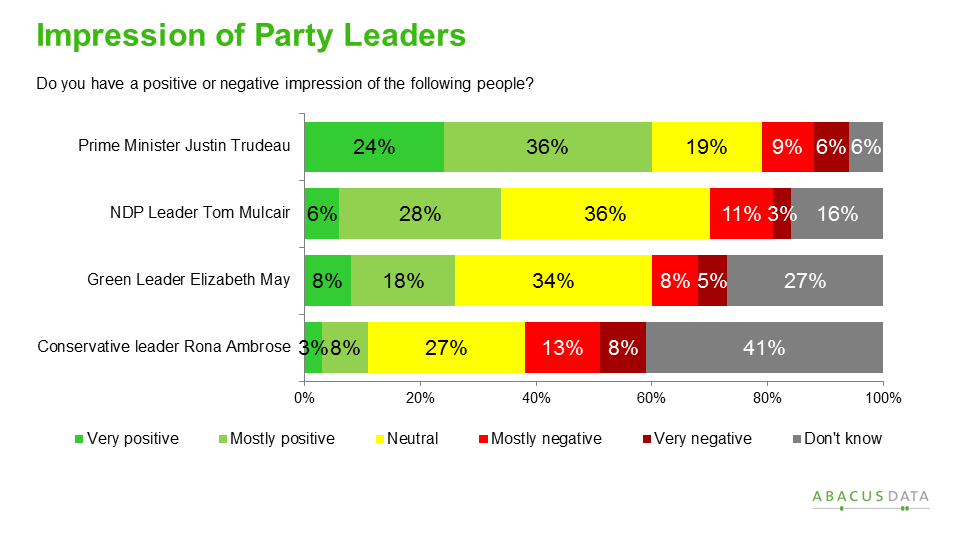
Impressions of Prime Minister Trudeau are strong across the country, with a majority of young Canadians in every region or province, except for Quebec, having a positive impression of him.
Prime Minister Trudeau: A political leader Canadian youth like and feel is in touch with them.
Not only do young Canadians have a positive general impression of Prime Minister Trudeau, but large majorities believe he understands young people in Canada and inspires them to care about Canadian politics. Similarly, most young people in Canada describe him as honest and trustworthy, and as someone who makes them proud to be Canadians.
Perhaps most important when it comes to political engagement among youth, two thirds of young Canadians say that Prime Minister Trudeau is a political leader they can relate to.
When young Canadians look at the Prime Minister and Liberal Party leader, they see someone who understands them, who they can relate to, and who makes them proud to be Canadians.
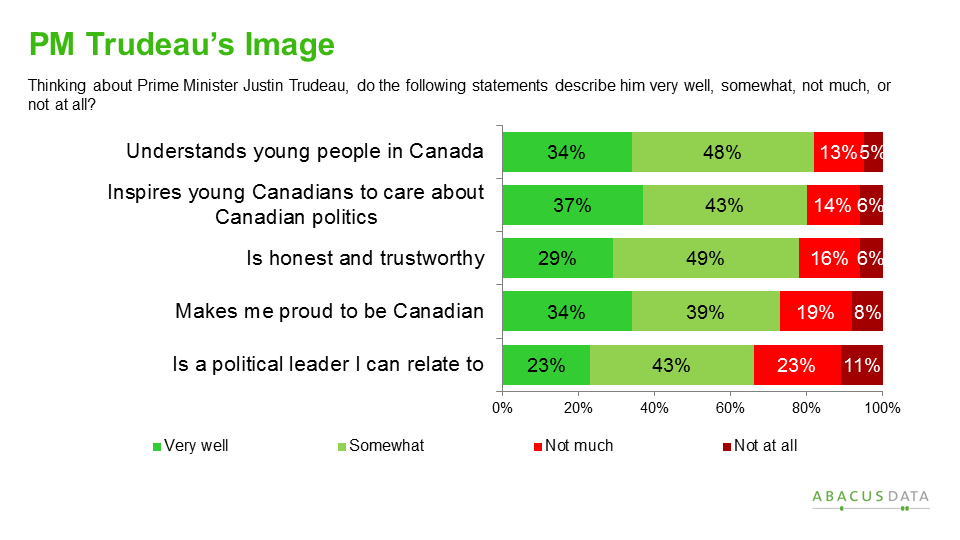
Impact of the Trudeau Government on young peoples’ lives
Young Canadians have high expectations for what the new government will mean for their lives. Most (61%) expect that the new federal government and Prime Minister Trudeau will make their life better – with 12% saying it will make their lives much better. 16% believe that the new government will make their lives worse, while 22% don’t think it will make much difference.
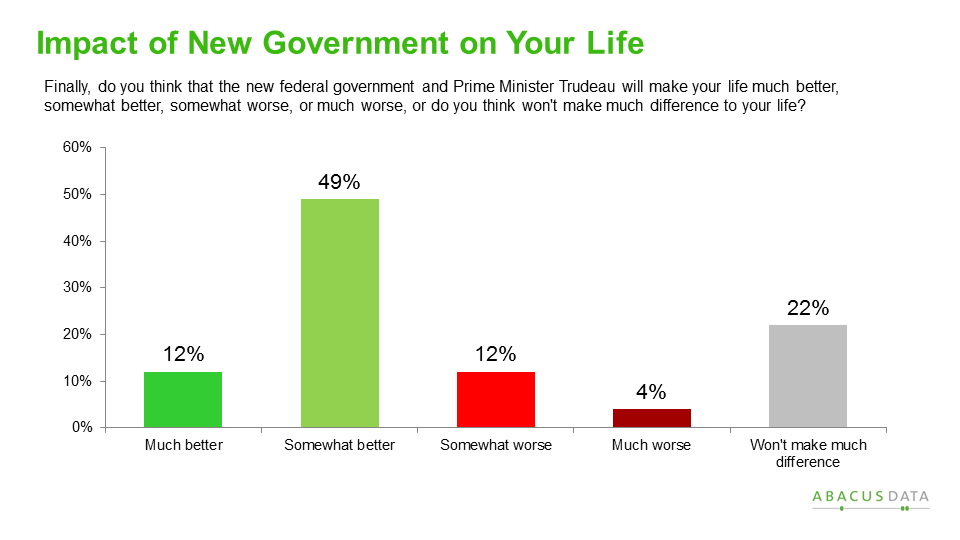
However, expectations differ depending on how one voted. 84% of Liberal voters believe that the new government will make their lives better, as do 59% of those who voted NDP in October. Interestingly, despite not voting Liberal, 25% of Conservative voters think the new government will make their lives better, while 52% think the new government will make their lives worse.
Post-secondary students are particularly optimistic, with 65% thinking the new government will make their lives better, compared with only 35% who say the new government will make things worse (14%) or won’t make much difference (21%).
What can the federal government do to make post-secondary education more accessible and affordable?
We asked respondents whether they would support or oppose the federal government implementing specific new proposals being advocated for by CASA. CASA’s student delegates advocated on these policy priorities during its annual Advocacy Week this past February, where they met with over 150 parliamentarians.
All five of the proposals we tested were supported by a majority of young Canadians. Two of these proposals were implemented in Budget 2016; increasing grants by 50%, and increasing the RAP threshold. The other recommendations remain important policies with strong support.
Budget 2016 changes –
• 75% support the changes announced in budget 2016 to increase the amount of grants to students through the Canada Student Grants Program from $250 per month to $375 per month for low-income households, and from $100 per month to $150 per month for middle-income households
• 70% support increasing the income level at which someone with student loans is eligible for the student loan repayment assistance program to $30,000, doubling the number of graduates eligible for the program. Budget 2016 expanded the RAP qualification level to $25,000, halfway to the goal supported by youth.
Additional recommendations from CASA –
• 71% support increasing the Canada Student Loans Program loan limit from $210 per week to $245 per week to provide more funding to students who need financial assistance.
• 70% support making graduate students eligible for the Canada Student Grants Program, which is currently only available to undergraduate students. The strong support for this policy shows recognition for the importance of graduate school among youth.
• 56% support increasing funding to the Post-Secondary Student Support Program, which is designed to support First Nations and Inuit learners to ensure that all those eligible for the program can receive funding. The government has announced the intention of making changes to these programs, but has not yet implemented them in the budget.
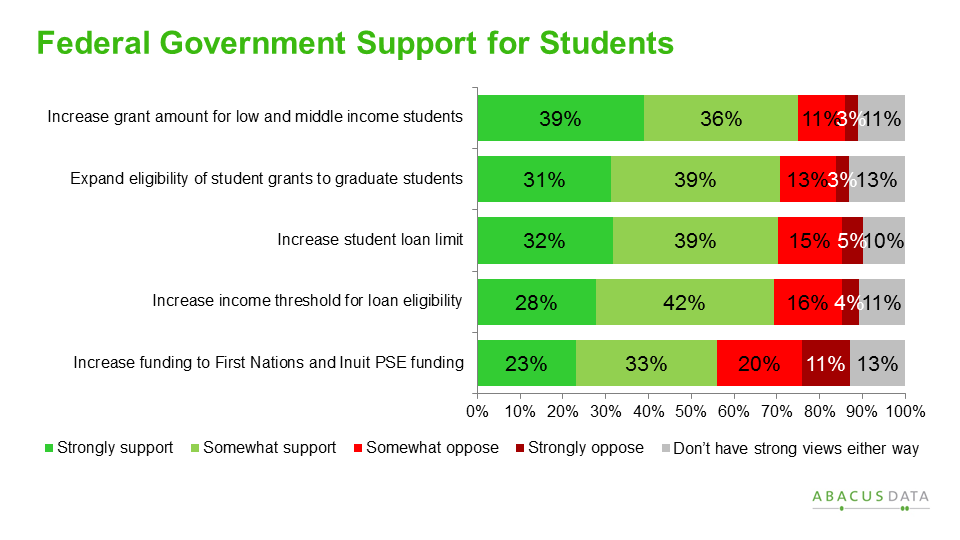
What’s Next? The state of mind of today’s young Canadians
Cost of food, post-secondary education, housing, debt levels, and the lack of good paying jobs in their field are having a negative effect on a majority young Canadians today
We asked young Canadians what effect a number of issues are having on them today, including the cost of food, cost of post-secondary education, cost of housing, debt levels, availability of jobs in their field, and saving for a down payment. In all of these areas, a plurality of young Canadians say they are having a negative impact on their life right now, with the rising cost of food, the cost of post-secondary education, and the cost of housing the most acute.
78% of young Canadians say that the rising cost of food is having a negative impact on their life with one in three (32%) saying food costs are having a very negative impact.
Post-secondary education costs are also impacting a large majority of young people (63%), especially among those currently enrolled (69% cite a negative impact on their lives).
The cost of housing, debt levels, and the availability of jobs are other stresses being felt by a majority of young Canadians.
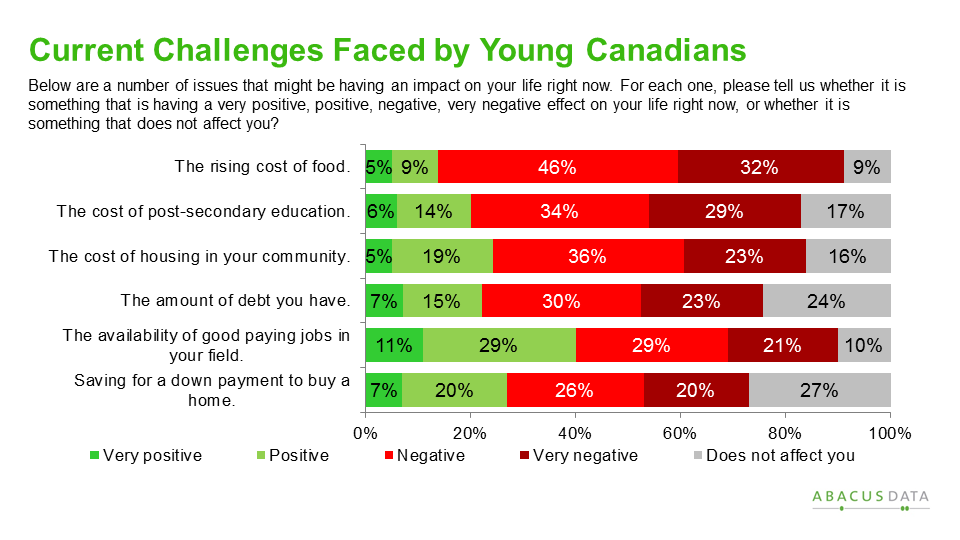
And these challenges are not being felt uniformly across socio-economic and regional groups. For example:
• The availability of jobs in their field are having more negative effects on those living in Ontario, BC, and Atlantic Canada, and among female young Canadians.
• The cost of post-secondary education is having a negative impact on more young Canadians in Ontario and Atlantic Canada (71% and 72% cite negative impacts) while Quebecers are less likely to report negative impacts related to the cost of PSE.
• Young Canadians from households making less than $35,000 per year are also the most likely to cite PSE costs as having a negative impact (69%), compared to 57% from households making $35,000 to $50,000 per year, and 47% among those making over $50,000 per year.
• The cost of housing is particularly challenging for young people living in BC (71% cited negative impacts) and Ontario (63% and 67% for those living in the GTA).
• Debt levels are more likely cited as having a negative impact on women (59% vs. 48% for men), those from lower income households (58%), and those whose parents make less than $50,000 per year (64%).
• Concerns about saving for a down payment to buy a home are more acute among older respondents (aged 24 and 25) and among young Canadians whose parents make less than $50,000 per year.
Post-secondary students are worried about their ability to achieve important milestones when they finish their education.
We asked young Canadians who are currently enrolled in post-secondary education how optimistic or worried they are about their ability to achieve a number of milestones when they finish school.
Overall, the results describe a cohort of Canadians who are worried about the future and their ability to achieve many of the things we come to expect in our lives.
While most students say they are optimistic that they will be able to do the things they enjoy to do outside of work and be able to make a living doing what they are passionate about, most worry about finding a good paying and secure job, finishing school without a lot of student debt, or being able to buy a home within five years of graduation.
Few believe that they will be able to count on Canada’s pension and old age security programs – only 33% say they are optimistic the system will be there for them when they need it
According to the 2015 CUSC Graduating Student Report, about 50% of university students report using some form of debt financing to pay for their university education, most often from government student loans (40%). The average debt among those reporting any debt is $26,819, with 29% of all students reporting debt of $20,000 or greater.
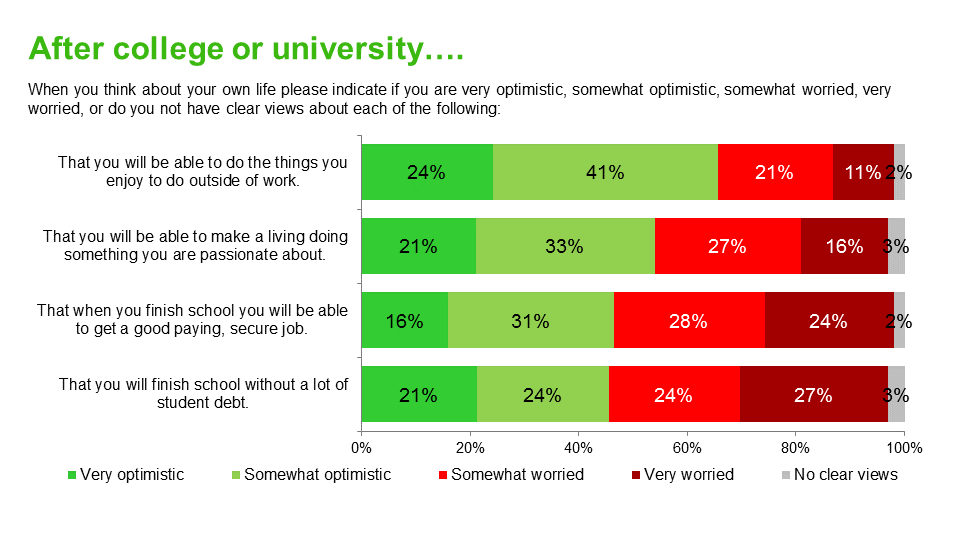
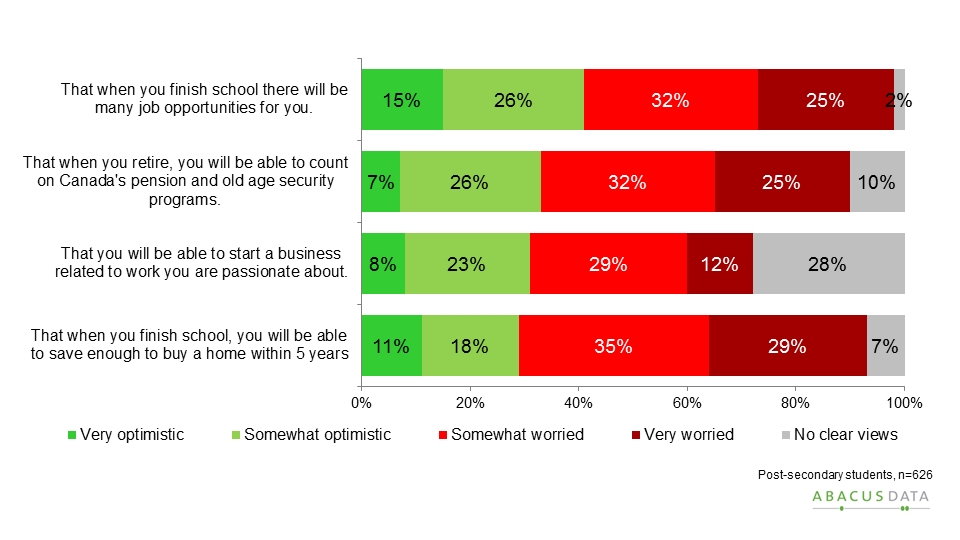
Many of these milestones are important to young Canadians. When asked how important it is for them to achieve a number of these milestones within five years, a majority considered them all at least somewhat important.
The most important milestones for more young Canadians to achieve in the next five years included finishing their education and finding a job that they love, followed by paying off their student debt.
Considering the financial and employment pressures faced by young Canadians today, it’s no surprise that 42% say that having a family of their own was not an important goal in the next five years.
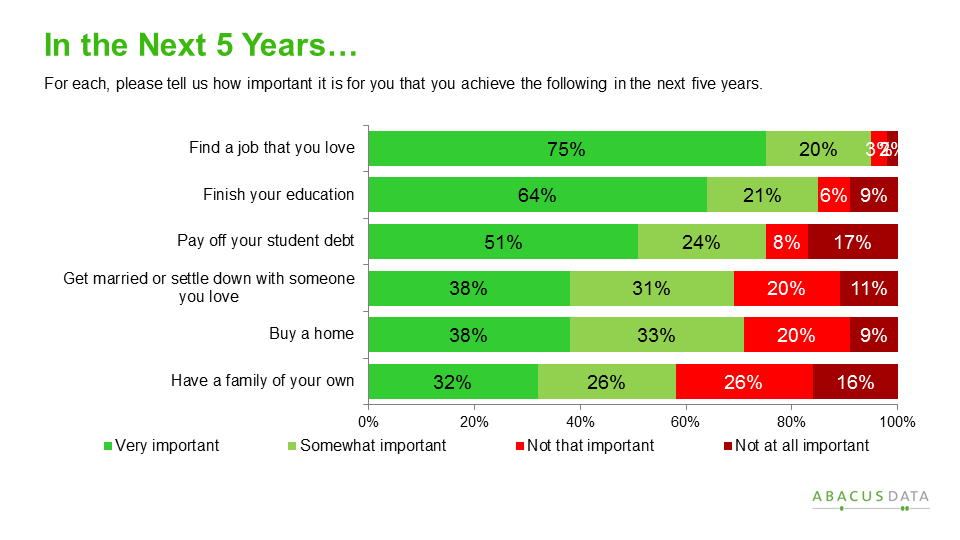
And yet, when we asked young people how likely it is that they will achieve these same goals, there are mixed reactions.
Most think they will likely finish their education in the next five years, and most are at least somewhat optimistic that they will find a job they love. Fewer are convinced that they will be able to buy a home or have a family of their own in the next five years.
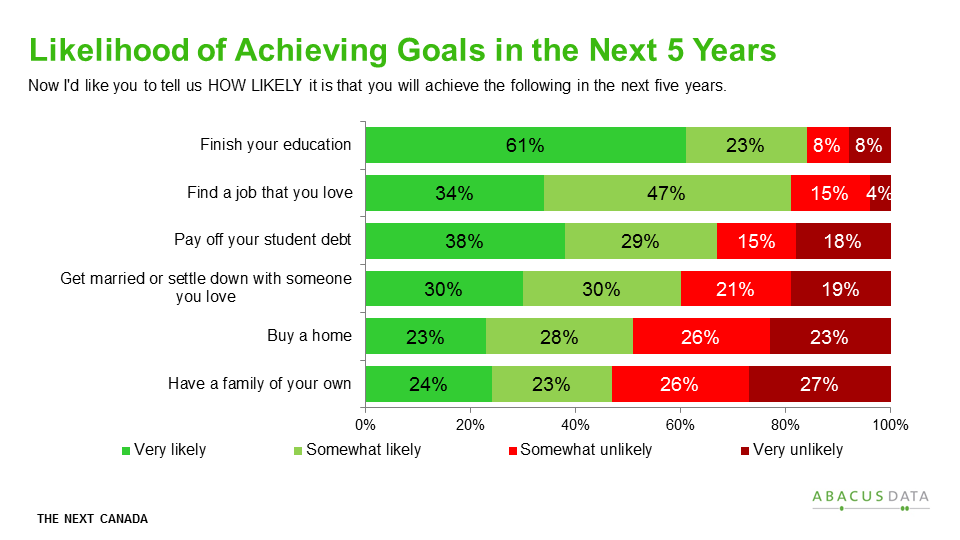
In fact, data from other Abacus Data surveys finds that more young Canadians are postponing important milestones in their life because of financial and employment pressures.
Moreover, according to the 2015 CUSC study, 70% of students plan to pursue further education, with a majority saying they plan to pursue graduate level education even though many say that their debt levels discourage them from going onto higher levels of study.
In a survey we conducted in 2014, only 63% of Canadians aged 20 to 35 had moved out of their family home, and only 60% considered themselves to be financially independent. Moreover, when asked at what age they expected to have children, the average expected age for young Canadians to start a family was 30.
And students are not the only ones affected by the costs of post-secondary education. In a June 2014 CASA-Abacus Data survey of parents of post-secondary students, 40% of parents said they were working more hours or got another job, 33% were dipping into their retirement savings, and 14% had remortgaged their home in order to help their child pay for their education. As CASA argued in the release of the findings, student debt is family debt, and the impact of debt accrued during PSE affects not just students, but entire families.
The shortfalls between hopes and expectations and the delayed achievement of basic milestones of an entire generation will continue to have meaningful impacts on the country.
Youth Employment: What is needed?
Lack of experience and opportunities are the biggest barriers for young Canadians looking for work while in school.
Most young Canadians believe that they do not have the experience employers are looking for when they are searching for a job.
When we asked them to rank the top three barriers preventing them from finding a job, the ones selected by the most respondents included a lack of experience (46%), employers not willing to invest and provide training (35%), and not having the right training and education (32%).
A lack of jobs in areas they are interested in and not having enough time for a job outside of school were selected by at least 20% of young Canadians we surveyed.
A 2014 Conference Board of Canada report found that Canada’s record on employer-sponsored trailed many OECD countries. Spending (in constant dollars) has declined by about 40%, from a peak of $1,207 per employee in 1993 to $705 in 2013. Although the latest results show a $17 increase in spending over 2010, it remains to be seen whether this is an anomaly or employers are, in fact, turning a corner.
U.S. employers have also decreased spending on employee learning and development in recent years, which suggests that Canada is not alone in terms of its downward trend. However, as of 2010, U.S. employer spending was still significantly higher ($1,071 per employee) than spending by Canadian employers ($688 per employee).
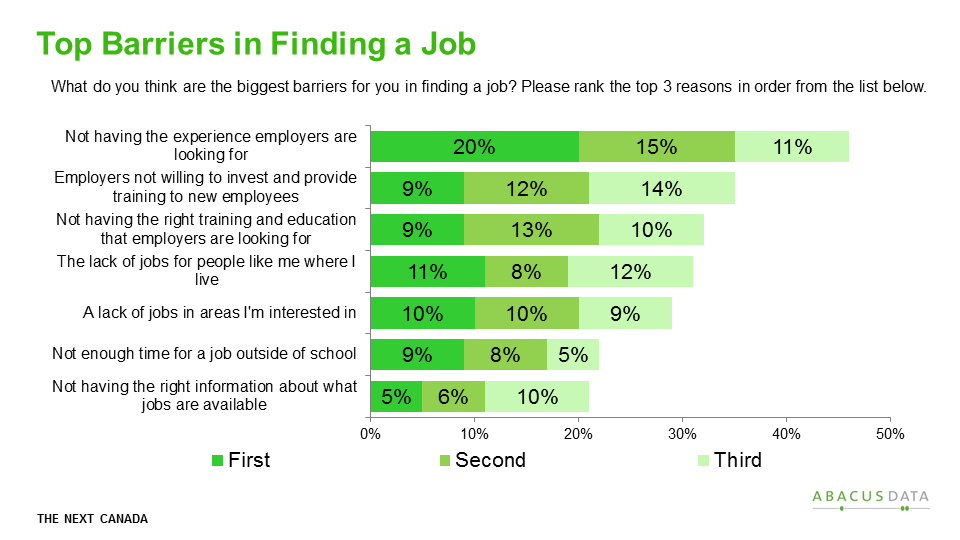
Considering these findings, it should be no surprise that most students feel that getting relevant work experience while studying would be the most helpful thing for them to get a job when they finish school. 67% ranked relevant experience as the most important, while 20% ranked having a mentor first, and 14% ranked getting advice on what employers are looking for in new employees.
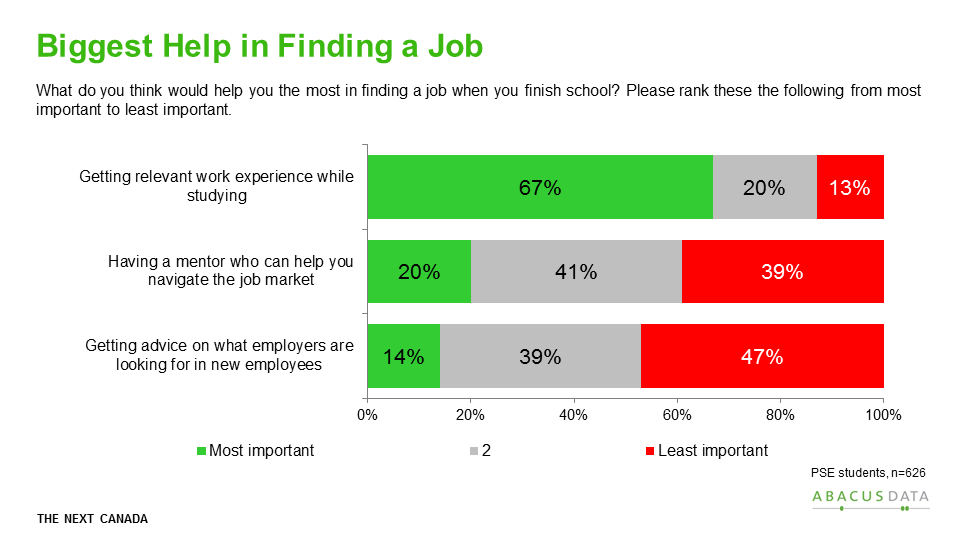
Data from the National Association of Colleges and Employers, an American based organization, demonstrates that unpaid internships have a negligible effect on employment, but paid internships are positively correlated to finding full-time employment.
The importance of relevant experience is even more important when we consider how young people that are currently employed describe their job.
Among those surveyed that are employed, many describe their current job as “the best they could find” (38%), or a “job, not a career” (38%). Only one in three believe their job is “good experience for their future career”. Few say their current job is in their field of study (30%), and even fewer describe their current job as rewarding (20%).
Perhaps the most worrisome, only one in five employed young people describe their current job as permanent (not contract).
Conclusion: It’s Time to Pay Attention to Young Canadians
On October 19, 2015, young Canadians from across the country made a statement. They voted in larger numbers than they had in the past. They voted overwhelmingly for one party. And, as a result, they likely turned a Liberal minority government into a majority.
They are a powerful voting bloc that is able, if engaged and mobilized, to change politics in Canada.
They should no longer be regarded as apathetic, unengaged, and misinformed about politics and public life. 2015 has proven that they can and will show up when asked to participate, and when political leaders reach out, engage, and offer them a reason to vote.
However, 2015 should not be regarded as a turning point on its own. It’s still too early to know whether the increased engagement we saw in 2015 will continue at other levels of government, or during the next federal election. Politicians who count on the support of young Canadians cannot take it for granted.
But there is hope that the voice and influence of young Canadians is here to stay.
1. By 2019, every member of the Millennial generation (those born between 1980 and 2000) will be eligible to vote. Millennials are the largest generation in Canada making up over 25% of the population. They will soon be the largest age cohort within the Canadian electorate.
2. Efforts by organizations like CIVIX have engaged millions of young people in the electoral process through the Student Vote program. Participation in the program has increased civic literacy and political confidence in an entire generation of new Canadian electors. In the 2015 Canadian election alone, almost a million students from over 6,500 schools participated in the program. Hundreds of thousands of these young Canadians will enter the electorate in 2019.
3. Other organizations like Apathy is Boring, Samara, Generation Squeeze, and CASA are engaging young people and encouraging them to get involved and exercise their right to be heard. Other youth serving agencies like Big Brothers Big Sisters, Boys and Girls Clubs of Canada, the National Association of Friendship Centres, Girl Guides, and Scouts Canada are building social capital in our communities and providing support to encourage the next generation of active Canadian citizens.
4. And in the 2016 federal budget, the Government of Canada announced the creation of the Prime Minister’s Youth Advisory Council, to advise the Prime Minister on “key issues such as employment and education, building stronger communities, as well as climate change and clean growth.”
Many of these youth driven organizations will be at the heart of sustaining efforts to engage youth cohorts into the future.
The voices of young people need to be heard. As this report highlighted, many are worried about their future. Rising education-related and living costs, unaffordable housing, and a difficult employment market have left this generation questioning their future prospects.
Furthermore, financial pressures and inequitable public policies have meant that young Canadians are delaying their achievement of basic life milestones like moving out, starting their career, getting married, having children, or buying their first home. Current and future governments that ignore this alarming trend will see unnecessary social and economic burdens fall on entire generation. There must be an urgency to invest in policies that help young people transition through their studies and into the workforce.
The implications of this new, engaged, and powerful voting group on federal politics cannot be overstated. In 2019, all political parties will need to pay attention to young people, engage them, and mobilize them to vote. 2015 has taught us that the collective impact of a mobilized youth vote can make a real difference to the outcome of elections in Canada.
Young Canadians embraced the hopeful message of change offered by Prime Minister Trudeau and the Liberal Party. Mr. Trudeau is a political leader young Canadians feel understands them and that they can relate to. The party engaged with young voters where they are: on campuses, on social media, and in their communities. Now, the task for Mr.Trudeau and the Liberal government is to sustain that meaningful engagement and deliver on the commitments they made during the election.
For the Conservative Party, this report presents some chilling findings. Fewer young Canadians voted Conservative in 2015 than at any point since 1997, and only 39% would even consider voting Conservative. As the party renews itself and elects a new leader, it must ask itself how it can reconnect and make itself relevant to young Canadians. In other words, what does a millennial-friendly conservatism look like?
Finally, for New Democrats, the challenge is how the party can re-engage with young voters. In its electoral breakthrough in 2011, the NDP was the top choice of voters aged 18 to 29, and it remains a party 60% would consider voting for. Prior to this election, it had made significant gains among Canada’s youngest voters. It must find a way recapture this momentum.
THE NEXT CANADA: Change Makers
CASA and Abacus Data will continue to track the views of young Canadians in the lead up to the next election to understand how they are responding to the decisions and policies of the Liberal government and opposition parties.
Young Canadians have high expectations of what Prime Minister Trudeau and his team can achieve in Ottawa. Many of them embraced the hopeful, aspirational message he campaigned on. The question is whether their enthusiasm and participation in the political life of Canada can be harnessed again in 2019.
The federal government was not the only thing that changed in October 2015. For the first time in many years, a large proportion of young Canadians turned out to vote and influenced the outcome of the election. Young Canadians have proven they can be a powerful voting group that decide elections. Political parties of all stripes need to listen to them, and incorporate solutions to the challenges they face into their political agendas if they hope to form or stay in government.
No longer can anyone write off young Canadians as an apathetic or disengaged group of citizens. It is now critical for politicians to realize that in the NEXT CANADA, young Canadians decide elections.



